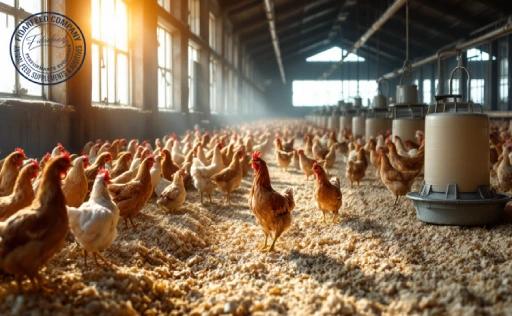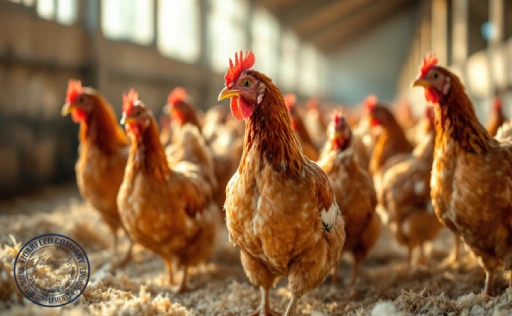Optimal Humidity for Broiler Chicken Performance isn’t just a technical detail—it’s a vital component of raising healthy, fast-growing birds. Whether you’re an experienced poultry farmer or just getting started, understanding how humidity influences broiler behavior, health, and productivity can transform your flock management and improve your bottom line. This article walks you through everything you need to know—from setting the right humidity levels to avoiding common mistakes. Keep reading to learn how to take control of this often-overlooked environmental factor.
Why Optimal Humidity for Broiler Chicken Performance Should Be a Top Priority
Humidity plays a central role in creating a stable and comfortable environment for broilers. If the air in your poultry house is too dry or too moist, it can stress the birds and affect their ability to grow efficiently. Proper humidity management helps prevent disease, improve feed conversion, and reduce mortality rates.
Learn more about: Product
When humidity is balanced, broilers expend less energy regulating their body temperature. This means more energy goes into growth—especially critical during the early stages of development. In short, when you manage humidity well, you’re not just improving comfort—you’re supporting profitability.
Understanding the Ideal Humidity Range for Broiler Growth and Comfort
So, what’s the sweet spot? The ideal relative humidity (RH) for broiler chickens typically ranges between 50% and 70%, depending on age and environmental conditions. Chicks in their first week of life do best around 60–70% RH to avoid dehydration. As they grow, the focus shifts more toward controlling excess moisture in the environment.
Learn more about: Cobb 500: The Broiler Breeder’s First Choice – Unveiled
Too much humidity can lead to wet litter and disease, while too little can cause dust and dehydration. Maintaining this balance is key to ensuring steady weight gain, optimal feed efficiency, and reduced stress.
How Poor Humidity Control Affects Broiler Health and Farm Efficiency
Extreme humidity conditions create a domino effect of health and management problems. High humidity can lead to wet litter, which encourages the growth of harmful bacteria and increases ammonia levels. This can irritate the birds’ respiratory systems, leading to coughing, reduced appetite, and slower growth.
On the other hand, low humidity contributes to dry, dusty air, irritating the eyes and lungs of both birds and humans. It also makes it harder for chicks to regulate their body heat, which can increase mortality in the early brooding phase.
Learn more about: Broiler Chicken Health at Risk? Know the Signs of Dysentery
Scientific studies have shown that broiler houses with poorly managed humidity have lower overall productivity and higher costs due to increased disease management and litter replacement.
Practical Tools and Techniques to Measure and Monitor Humidity Levels
Monitoring humidity doesn’t require high-tech equipment. Affordable digital hygrometers are widely available and provide accurate RH readings in real time. Place them at bird height in multiple areas of the poultry house to get an accurate picture of the environment.
Advanced growers may also use integrated climate control systems that adjust ventilation, heating, and humidification/dehumidification automatically. However, even manual systems can be highly effective when farmers monitor consistently and adjust based on the data.
The Role of Ventilation in Maintaining Optimal Humidity for Broiler Chicken Performance
Ventilation is your first and most powerful tool for managing humidity. By controlling air exchange, you remove excess moisture produced by the birds’ respiration, droppings, and drinker systems.
Learn more about: how to breed broiler chickens
Proper airflow helps keep the litter dry, the air fresh, and the temperature consistent. Tunnel ventilation, sidewall inlets, and ceiling fans can all be configured to optimize humidity levels. Remember, stale, humid air is your enemy—especially in tightly sealed houses during winter months.
Humidity and Litter Quality: Why Dry Bedding Means Healthier Chickens
The connection between humidity and litter quality is direct and critical. Wet litter becomes a breeding ground for pathogens, increases ammonia emissions, and causes footpad dermatitis, which reduces animal welfare and carcass quality.
To keep bedding dry, maintain RH below 70% after the brooding phase, ensure proper drinker management (no leaks or spillage), and clean out wet spots promptly. Farmers who consistently manage litter dryness see better bird performance and fewer health interventions.
Seasonal Humidity Challenges and How to Manage Them Effectively
Humidity management is especially tricky during seasonal transitions. In winter, reduced ventilation to conserve heat often leads to moisture buildup. In summer, high outside humidity can overwhelm your ventilation system.
Learn more about: Ross 308 vs. Cobb 500: Which Broiler Breed is Right for You?
During cold seasons, use minimum ventilation rates to exchange air without major heat loss. In hot and humid weather, increase airspeed and use evaporative cooling pads wisely to balance temperature and moisture. Always monitor and adjust as needed to maintain consistency.
Balancing Temperature and Humidity for Best Broiler Performance
Temperature and humidity are tightly linked. Warm air holds more moisture, so simply raising or lowering the temperature without considering RH can backfire. For instance, increasing heat may dry the litter, but also raise RH if ventilation isn’t adjusted accordingly.
Learn more about: Mastering the Basics: A Comprehensive Broiler Breeder Management Guide
The goal is to create a balanced thermal environment. Use a temperature-humidity index (THI) to assess stress levels and adjust ventilation, heating, or humidification systems accordingly. Keeping both temperature and humidity in harmony ensures broilers thrive with fewer setbacks.
Common Mistakes in Managing Humidity—and How to Avoid Them
Even well-meaning farmers can make mistakes that throw off humidity levels. Here are some common pitfalls:
-
Neglecting equipment maintenance, leading to blocked vents or leaking drinkers.
-
Overcrowding, which increases moisture output and heat in the house.
-
Failing to calibrate sensors, resulting in inaccurate RH readings.
-
Poor insulation, causing condensation and wet litter in cold weather.
Avoid these mistakes by developing a regular monitoring and maintenance schedule and by training staff to identify and respond to environmental red flags.
Long-Term Benefits of Humidity Control for Broiler Growth, Welfare, and Profit
When you get humidity control right, everything else starts to fall into place. Broilers grow more predictably. Feed is used more efficiently. Litter stays drier. Health improves, and so does overall welfare.
But beyond the day-to-day benefits, long-term humidity management reduces costs, labor, and the need for antibiotics or treatments. Healthy birds lead to more uniform batches, better weight gain, and ultimately, higher profitability for your farm.
Conclusion
Mastering Optimal Humidity for Broiler Chicken Performance isn’t optional—it’s essential. From early brooding to final days before slaughter, humidity affects every aspect of bird health, comfort, and productivity. By paying close attention to airflow, litter quality, and seasonal challenges, farmers can prevent problems before they start and ensure steady, efficient growth.
We’d love to hear from you—have you faced humidity challenges on your farm? What solutions have worked best for your flock? Leave a comment, ask a question, or share your insights below. Let’s keep learning together and help more broilers thrive under the best possible conditions










